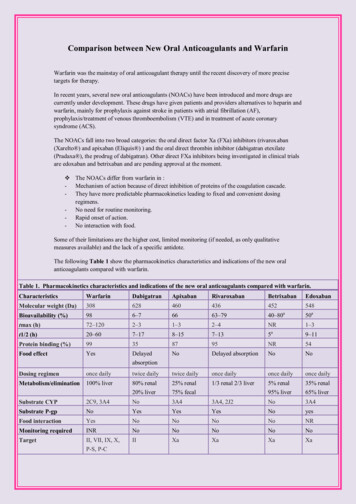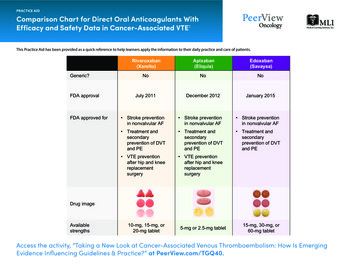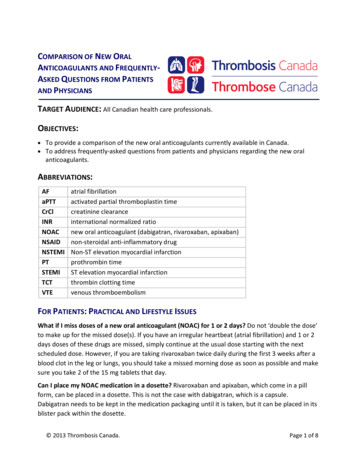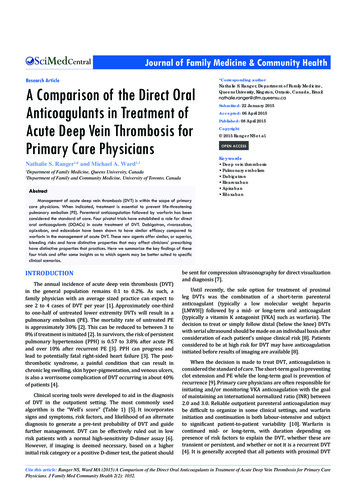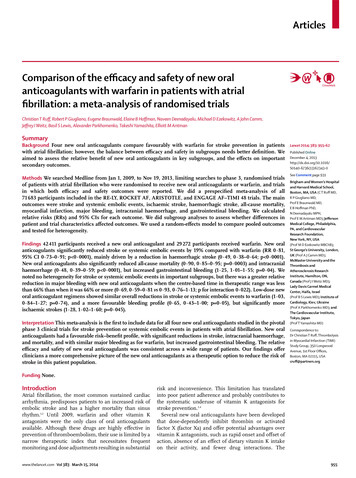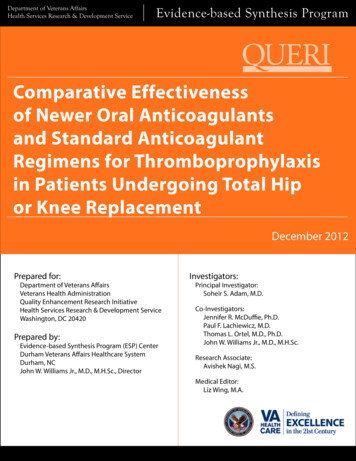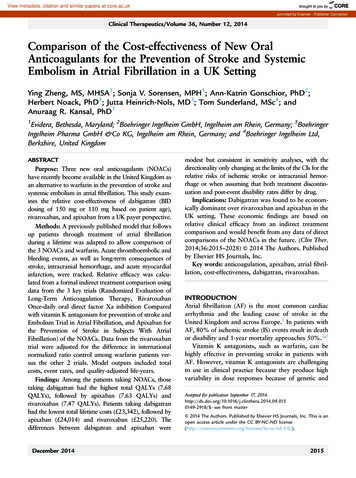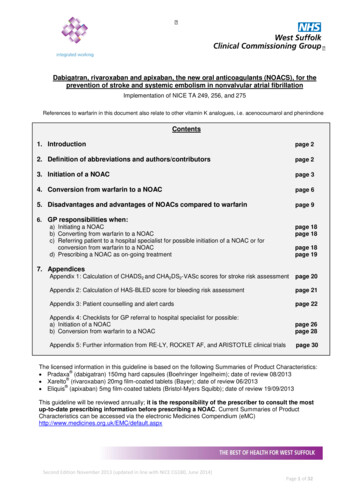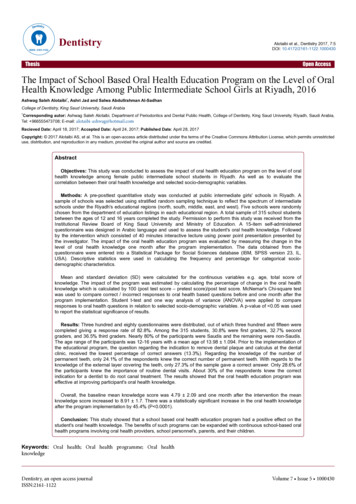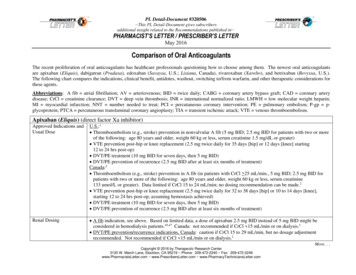
Transcription
PL Detail-Document #320506 This PL Detail-Document gives subscribersadditional insight related to the Recommendations published in PHARMACIST’S LETTER / PRESCRIBER’S LETTERMay 2016Comparison of Oral AnticoagulantsThe recent proliferation of oral anticoagulants has healthcare professionals questioning how to choose among them. The newest oral anticoagulantsare apixaban (Eliquis), dabigatran (Pradaxa), edoxaban (Savaysa, U.S.; Lixiana, Canada), rivaroxaban (Xarelto), and betrixaban (Bevyxxa, U.S.).The following chart compares the indications, clinical benefit, antidotes, washout, switching to/from warfarin, and other therapeutic considerations forthese agents.Abbreviations: A fib atrial fibrillation; AV arteriovenous; BID twice daily; CABG coronary artery bypass graft; CAD coronary arterydisease; CrCl creatinine clearance; DVT deep vein thrombosis; INR international normalized ratio; LMWH low molecular weight heparin;MI myocardial infarction; NNT number needed to treat; PCI percutaneous coronary intervention; PE pulmonary embolism; P-gp pglycoprotein; PTCA percutaneous transluminal coronary angioplasty; TIA transient ischemic attack; VTE venous thromboembolism.Apixaban (Eliquis) (direct factor Xa inhibitor)Approved Indications andUsual DoseU.S.:1 Thromboembolism (e.g., stroke) prevention in nonvalvular A fib (5 mg BID; 2.5 mg BID for patients with two or moreof the following: age 80 years and older, weight 60 kg or less, serum creatinine 1.5 mg/dL or greater) VTE prevention post-hip or knee replacement (2.5 mg twice daily for 35 days [hip] or 12 days [knee] starting12 to 24 hrs post-op) DVT/PE treatment (10 mg BID for seven days, then 5 mg BID) DVT/PE prevention of recurrence (2.5 mg BID after at least six months of treatment)Canada:2 Thromboembolism (e.g., stroke) prevention in A fib (in patients with CrCl 25 mL/min., 5 mg BID; 2.5 mg BID forpatients with two or more of the following: age 80 years and older, weight 60 kg or less, serum creatinine133 umol/L or greater). Data limited if CrCl 15 to 24 mL/min; no dosing recommendation can be made.2 VTE prevention post-hip or knee replacement (2.5 mg twice daily for 32 to 38 days [hip] or 10 to 14 days [knee],starting 12 to 24 hrs post-op, assuming hemostasis achieved) DVT/PE treatment (10 mg BID for seven days, then 5 mg BID) DVT/PE prevention of recurrence (2.5 mg BID after at least six months of treatment)Renal Dosing A fib indication, see above. Based on limited data, a dose of apixaban 2.5 mg BID instead of 5 mg BID might beconsidered in hemodialysis patients.45,47 Canada: not recommended if CrCl 15 mL/min or on dialysis.2 DVT/PE prevention/recurrence indications, Canada: caution if CrCl 15 to 29 mL/min, but no dosage adjustmentrecommended. Not recommended if CrCl 15 mL/min or on dialysis.2More. . .Copyright 2016 by Therapeutic Research Center3120 W. March Lane, Stockton, CA 95219 Phone: 209-472-2240 Fax: 209-472-2249www.PharmacistsLetter.com www.PrescribersLetter.com www.PharmacyTechniciansLetter.com
(PL Detail-Document #320506: Page 2 of 15)Apixaban, continuedClinical Benefit In aA fib: for every 1000 patients treated per year, apixaban prevents three more strokes, avoids ten major bleeds, andprevents four deaths compared to warfarin.3Post-hip/knee replacement: at least as effective as enoxaparin for preventing VTE; comparable bleeding.4,5DVT/PE treatment/prevention of recurrence: comparable to enoxaparin/warfarin for prevention of recurrent VTE orVTE death (combined endpoint); less bleeding.40Antidote/pre-op, preprocedure washout(if indicated)TherapeuticConsiderationsNo specific antidote. See our chart, Managing Bleeding with the New Oral Anticoagulants, and commentaries, StoppingAntithrombotics Before Surgery and Managing Antithrombotics Before Minor Procedures. Requires BID dosing.1,2 Not recommended in patients with prosthetic heart valves.1,2 Canada: not recommended in hemodynamicallysignificant rheumatic heart disease, especially mitral stenosis.2 Severe liver impairment: not recommended (U.S.).1 Canada: contraindicated in hepatic disease with coagulopathyand clinically significant bleeding risk.2 Prophylax for at least 10 to 14 days after hip or knee replacement, and up to 35 days, especially after hip replacement.17 For VTE treatment, continue for at least three months.18 Benefit of extended use may not outweigh risk in patientswith high bleeding risk.18Switching To/From OtherAnticoagulants To switch from warfarin, stop warfarin, then start apixaban when INR 2.1,2 To switch to warfarin: apixaban increases INR, thus confounding initial warfarin dosing.1,2 U.S.: Consider starting aparenteral anticoagulant plus warfarin when the next dose of apixaban would have been due, then discontinuing theparenteral agent when the INR reaches the desired range.1 Canada: continue apixaban with warfarin until the INR is 2. Use the “usual” initial warfarin dose for the first two days. Thereafter, check INR just prior to the next dose ofapixaban to minimize apixaban interference with the INR.2 See product labeling for instructions for switching to/from other anticoagulants.Select Drug Interactions U.S.: reduce dose by 50% with strong inhibitors of BOTH CYP3A4 and P-gp (e.g., itraconazole, ketoconazole,ritonavir, clarithromycin). Avoid in patients already taking 2.5 mg BID.1 Canada: contraindicated. Canadiancontraindication also includes posaconazole, voriconazole, and HIV protease inhibitors.2 Avoid strong inducers of BOTH CYP3A4 and P-gp (e.g., carbamazepine, phenytoin, phenobarbital, St. John’s wort,rifampin).1,2 Caution with antiplatelets and anticoagulants (U.S.).1 Canada: anticoagulants contraindicated; caution withContinued More. . .Copyright 2016 by Therapeutic Research Center3120 W. March Lane, Stockton, CA 95219 Phone: 209-472-2240 Fax: 209-472-2249www.PharmacistsLetter.com www.PrescribersLetter.com www.PharmacyTechniciansLetter.com
(PL Detail-Document #320506: Page 3 of 15)Apixaban, continuedSelect Drug Interactions,ContinuedCost of 30-day supplybantiplatelets. Prasugrel and ticagrelor not recommended.2 Dual antiplatelet therapy about doubles bleeding risk.62.5 mg BID or 5 mg BID. U.S.: 359.92, Canada: 103.68Betrixaban (Bevyxxa [U.S.]) (direct factor Xa inhibitor)Approved Indications andUsual Dose VTE prevention in acutely ill medical, non-surgical patients with moderate or severely limited mobility plus other VTErisk factors (160 mg x 1, then 80 mg once daily with food, for 35 to 42 days)48Renal dosing For CrCl 15 to 30 mL/min (calculated using actual body weight): 80 mg x 1, then 40 mg once daily with food for35 to 42 days.48 Patients with CrCl 15 mL/min, dialysis patients, and patients likely to need dialysis within three months wereexcluded from the clinical trial used for FDA approval.49 It is unknown if betrixaban is removed by hemodialysis.48Clinical Benefit In a VTE prevention in acutely ill medical patients: vs about 10 days’ treatment with enoxaparin, NNT to prevent onesymptomatic event (symptomatic DVT, non-fatal PE, or VTE death) 167.48 NNT 63 to prevent one asymptomaticor symptomatic VTE.49 Comparable major bleeding, but NNH 90 for clinically important (but nonmajor) bleedingthat may require prescriber contact, intervention (e.g., drug discontinuation), or patient discomfort.48 NNT 170 toprevent one VTE-related readmission.51Antidote/pre-op, preprocedure washout(if indicated) No specific antidote. See our chart, Managing Bleeding with the New Oral Anticoagulants, for general information. Half-life 19 to 27 hours.48 Expect betrixaban’s effect to last for at least 72 hours after the last dose.48 Do not remove epidural catheter sooner than 72 hours after the last dose, and do not give betrixaban sooner than fivehours after catheter removal. Delay betrixaban use for 72 hours in the event of traumatic puncture.48TherapeuticConsiderations U.S. approval was based on the APEX clinical trial.48 Enrolled patients were at high risk of VTE. Patients wererequired to have an elevated D-dimer or be 75 years or older, in addition to having restricted mobility plusdecompensated heart failure, acute respiratory failure, infection, ischemic stroke, or acute rheumatic disease.49 Notable APEX exclusion criteria included body weight 45 kg; dual antiplatelet therapy; recent significant bleeding,trauma, peptic ulcer disease, or major surgery; potential need for major surgery; active lung cancer; or low platelets.49 Not indicated for patients with prosthetic heart valves due to lack of data.48 Avoid use in hepatic impairment.48 Less than 6% of betrixaban patients in the trial used for FDA approval had a CrCl of 15 to 30 mL/min.49 Few APEX enrollees had a history of cancer or VTE. Only 18% received a reduced dose due to P-gp interaction.49More. . .Copyright 2016 by Therapeutic Research Center3120 W. March Lane, Stockton, CA 95219 Phone: 209-472-2240 Fax: 209-472-2249www.PharmacistsLetter.com www.PrescribersLetter.com www.PharmacyTechniciansLetter.com
(PL Detail-Document #320506: Page 4 of 15)Betrixaban, continuedSwitching To/From OtherAnticoagulants No data.Select Drug Interactions Reduce dose to 40 mg once daily (after 80 mg loading dose) with strong P-gp inhibitors (e.g., amiodarone,azithromycin, clarithromycin, ketoconazole, verapamil).48 Patients with CrCl 15 to 30 mL/min requiring a strong P-gpinhibitor were excluded from the clinical trial used for FDA approval.49 Avoid in such patients.48 Caution with antiplatelets and anticoagulants.48 Not studied in patients requiring dual antiplatelet therapy.4940 or 80 mg once daily. U.S.: 450cCost of 30-day supplybDabigatran (Pradaxa) (direct thrombin inhibitor)Approved Indications andUsual DoseU.S.:7 Thromboembolism (e.g., stroke) prevention in nonvalvular A fib (150 mg BID) DVT/PE treatment (following 5 to 10 days’ treatment with a parenteral anticoagulant)/prevention of recurrence(150 mg BID). (Start 0 to 2 hours before the next dose of parenteral anticoagulant would have been due, or at the timeof discontinuation of heparin drip.) VTE prevention post-hip replacement (220 mg once daily x 28 to 35 days. If started on day of surgery [1 to 4 hrs postop, assuming hemostasis achieved], initial dose is 110 mg).Canada:8 Thromboembolism (e.g., stroke) prevention in A fib (150 mg BID; 110 mg BID for patients 80 years, and for patientsat higher risk of bleeding, including patients 75 years of age with at least one other bleeding risk factor; also considerfor other elderly. VTE prevention post-hip or knee replacement (220 mg once daily x 10 days [knee] or 28 to 35 days [hip]. If started onday of surgery, normally within 1 to 4 hrs post-op, assuming hemostasis achieved, initial dose is 110 mg. Consider150 mg once daily for patients over 75 years). DVT/PE treatment (following 5 to 10 days’ treatment with a parenteral anticoagulant)/prevention of recurrence(150 mg BID; 110 mg BID for patients 80 years, and for patients at higher risk of bleeding, including patients 75 years of age with at least one other bleeding risk factor). (Start 0 to 2 hours before the next dose of parenteralanticoagulant would have been due, or at the time of discontinuation of heparin drip.)Renal Dosing Check renal function at baseline, yearly (Canada), and when clinically indicated.7,8 Also see drug interactions section, below. Canada, contraindicated if CrCl 30 mL/min.8 A fib (U.S.): use 75 mg BID if CrCl 15 to 30 mL/min.7 No dosing information for CrCl 15 mL/min or dialysis.7 DVT/PE treatment/prevention and VTE prevention post-hip replacement (U.S.): no dosing information forCrCl 30 mL/min or dialysis.7Continued More. . .Copyright 2016 by Therapeutic Research Center3120 W. March Lane, Stockton, CA 95219 Phone: 209-472-2240 Fax: 209-472-2249www.PharmacistsLetter.com www.PrescribersLetter.com www.PharmacyTechniciansLetter.com
(PL Detail-Document #320506: Page 5 of 15)Dabigatran, continuedRenal dosing,continuedClinical Benefit In a DVT/PE treatment/prevention (Canada): for CrCl 30 to 50 mL/min., a dose reduction to 110 mg BID can beconsidered based on risk/benefit, but is not recommended.8 VTE prevention post-hip/knee replacement (Canada): for CrCl 30 to 50 mL/min., dose is 150 mg once daily. If startedon day of surgery, normally within 1 to 4 hrs post-op, assuming hemostasis is achieved, initial dose is 75 mg.8A fib: prevents about five more strokes per 1000 patients per year than warfarin. Lower rate of hemorrhagic andischemic stroke, higher rate of major GI bleed, comparable overall bleeding.10Post-hip/knee replacement: comparable to enoxaparin for prevention of VTE & mortality (combined endpoint);comparable major bleeding.11-13DVT/PE treatment/prevention of recurrence: comparable to warfarin for prevention of recurrent VTE or VTE death(combined endpoint); comparable major bleeding.14Antidote/pre-op, preprocedure washout (if ind.)Reversal agent: Praxbind (idarucizumab). See our chart, Managing Bleeding with the New Oral Anticoagulants, andcommentaries, Stopping Antithrombotics Before Surgery and Managing Antithrombotics Before Minor Procedures.TherapeuticConsiderations Requires BID dosing for A fib and DVT/PE treatment/prevention indications.7,8 Causes gastrointestinal symptoms in over 10% of patients.7 Caution if 75 years or older, poor renal function, or underweight.7-9 Contraindicated with mechanical heart valve, and not recommended with bioprosthetic valves (U.S.).7 Canada:contraindicated in patients requiring anticoagulation for a prosthetic heart valve. Not recommended in patients withhemodynamically significant rheumatic heart disease, especially mitral stenosis.8 Dispense/store in original package.7,8 Once bottle opened, use within 4 months.7,8 For VTE treatment, continue for at least three months.8,18 Benefit of extended use may not outweigh risk in patientswith high bleeding risk.18 Prophylax for at least 10 to 14 days after hip or knee replacement, and up to 35 days, especially after hip replacement.17Switching To/From OtherAnticoagulants To switch from warfarin, stop warfarin, then start dabigatran when INR 2.7,8 To switch to warfarin, start warfarin three days (if CrCl 50 mL/min), two days (if CrCl 30 to 50 mL/min), or one day(if CrCl 15 to 30 mL/min [U.S.]) before discontinuing dabigatran.7,8 No recommendations are available for patientswith CrCl 15 mL/min.7 See product labeling for instructions for switching to/from other anticoagulants.More. . .Copyright 2016 by Therapeutic Research Center3120 W. March Lane, Stockton, CA 95219 Phone: 209-472-2240 Fax: 209-472-2249www.PharmacistsLetter.com www.PrescribersLetter.com www.PharmacyTechniciansLetter.com
(PL Detail-Document #320506: Page 6 of 15)Dabigatran, continuedSelect Drug Interactions P-gp inhibitors may increase dabigatran levels.7,8 Ketoconazole and other strong P-gp inhibitors contraindicated (Canada).8 A fib indication (U.S.): avoid P-gp inhibitors if CrCl 30 mL/min.7 Reduce dose to 75 mg BID with ketoconazoleor dronedarone if CrCl 30 to 50 mL/min.7 VTE/PE treatment/prevention (including post-hip replacement)(U.S.):7 avoid use of P-gp inhibitors ifCrCL 50 mL/min.7 VTE prevention post-hip/knee replacement (Canada): use 150 mg once daily with the P-gp inhibitors amiodarone,verapamil, and quinidine. Consider 75 mg once daily in patients taking verapamil who also have moderate renalimpairment.8 Verapamil initiation should be avoided following orthopedic surgery in patients already takingdabigatran.8 Give dabigatran 2 hrs before quinidine (A fib) or verapamil (Canada).8 P-gp inducers could decrease dabigatran efficacy.7,8 Avoid P-gp inducers per U.S. labeling (Canada: avoid strongerinducers [e.g., rifampin, carbamazepine, phenytoin, St. John’s wort]).7,8 Caution with antiplatelets.7,8 Ticagrelor or prasugrel not recommended (Canada).8 Use with aspirin 100 mg or less canbe considered.8 Co-administration with aspirin or clopidogrel about doubles bleeding risk.8 Caution withanticoagulants (Canada: contraindicated).7,8 Drugs that increase gastric pH could reduce efficacy. Take dabigatran at least 2 hrs before antacids. Avoid antacidsfor 24 hrs after hip/knee replacement (Canada).8Cost of 30-day supplyb150 mg BID. U.S.: 333.57, Canada: 106.80 (Pradaxa savings card can reduce out-of-pocket cost by up to 2400 peryear for U.S. patients with private insurance. Other patients can get a free 30-day supply at www.pradaxa.com.)Edoxaban (Savaysa [U.S.], Lixiana [Canada]) (direct factor Xa inhibitor)Approved Indications andUsual DoseU.S.:41 Thromboembolism (e.g., stroke) prevention in nonvalvular A fib in patients with CrCl 50 to 95 mL/min (60 mgonce daily). DVT/PE treatment (following 5 to 10 days’ treatment with a parenteral anticoagulant) (60 mg once daily; 30 mg oncedaily if body weight 60 kg).Canada:44 Thromboembolism (e.g., stroke) prevention in nonvalvular A fib in patients (60 mg once daily; 30 mg once daily ifbody weight 60 kg). DVT/PE treatment/prevention of recurrence (following 5 to 10 days’ treatment with a parenteral anticoagulant) (60 mgonce daily; 30 mg once daily if body weight 60 kg).More. . .Copyright 2016 by Therapeutic Research Center3120 W. March Lane, Stockton, CA 95219 Phone: 209-472-2240 Fax: 209-472-2249www.PharmacistsLetter.com www.PrescribersLetter.com www.PharmacyTechniciansLetter.com
(PL Detail-Document #320506: Page 7 of 15)Edoxaban (Savaysa [U.S.], Lixiana [Canada]), continuedRenal DosingU.S.:41 A fib: 60 mg once daily for CrCl 50 to 95 mL/min, or 30 mg once daily for CrCl 15 to 50 mL/min. Not for use inpatients with CrCl 95 mL/min. DVT/PE treatment: 30 mg once daily for CrCl 15 to 50 mL/min. Not recommended if CrCl 15 mL/min.Canada:44 30 mg once daily for CrCl 30 to 50 mL/min. Not recommended if CrCl 30 mL/min.Clinical Benefit In aA fib: about as effective as warfarin, with lower risk of major bleeding (six fewer bleeds per1000 patients per year).42 (Also see “Therapeutic Considerations,” below.)DVT/PE treatment: About as effective as warfarin, with less bleeding (18 fewer bleeds [composite of major plusclinically relevant nonmajor bleeding] per 1000 patients per year).43Antidote/pre-op, preprocedure washout (ifindicated)No specific antidote. See our chart, Managing Bleeding with the New Oral Anticoagulants. Discontinue at least24 hours before invasive procedures/surgery.41,44 Canada: consider stopping at least 48 hours if complete hemostasis isdesired or in patients at particularly high bleeding risk.44 See our commentaries, Stopping Antithrombotics BeforeSurgery and Managing Antithrombotics Before Minor Procedures. For A fib, concerns that efficacy may be less than warfarin at higher CrCl is reflected in the U.S. prescribinginformation, but Canadian labeling does not reflect these concerns. Numerical differences are small and notstatistically significant.41,44 Not recommended in patients with mechanical heart valves or moderate to severe mitral stenosis (U.S.).41 Canada: notrecommended in patients with prosthetic heart valves or hemodynamically significant rheumatic heart disease,especially mitral stenosis.44 For VTE treatment, continue for at least three months.18 Benefit of extended use may not outweigh risk in patientswith high bleeding risk.18 Not recommended in moderate or severe hepatic impairment (U.S.).41 Canada: not recommended in severe hepaticimpairment. Contraindicated in hepatic disease with coagulopathy and clinically significant bleeding risk.44TherapeuticConsiderationsSwitching To/From OtherAnticoagulants To switch from warfarin, stop warfarin, then start edoxaban when INR 2.5.41,44 To switch to warfarin, reduce edoxaban dose by half and start warfarin. Check INR at least weekly, just prior toedoxaban dose. Stop edoxaban once INR is 2 and is stable.41,44 Alternatively, stop edoxaban and “bridge” with aparenteral anticoagulant until INR is 2 and is stable.41,44 See product labeling for instructions for switching to/from other anticoagulants.More. . .Copyright 2016 by Therapeutic Research Center3120 W. March Lane, Stockton, CA 95219 Phone: 209-472-2240 Fax: 209-472-2249www.PharmacistsLetter.com www.PrescribersLetter.com www.PharmacyTechniciansLetter.com
(PL Detail-Document #320506: Page 8 of 15)Edoxaban (Savaysa [U.S.], Lixiana [Canada]), continuedSelect Drug Interactions Use with anticoagulants not recommended (Canada: contraindicated, except when switching).41,44 Caution withantiplatelets.41,44 Avoid rifampin (P-gp inducer).41 Canadian labeling also recommends avoiding use of other strong CYP3A4 and P-gpinducers (e.g. phenytoin, carbamazepine, phenobarbital).44 U.S.: Reduce dose to 30 mg once daily for DVT/PE indication in patients taking certain P-gp inhibitors (e.g.,azithromycin, clarithromycin, erythromycin, itraconazole [oral], ketoconazole [oral], quinidine, or verapamil).41Canada: reduce dose to 30 mg once daily with certain P-gp inhibitors (e.g., cyclosporine, dronedarone, erythromycin,ketoconazole, quinidine, but NOT amiodarone or verapamil).44Cost of 30-day supplyb60 mg or 30 mg once daily. U.S.: 291.30, Canada: 92.02Savaysa savings card can reduce out-of-pocket cost to U.S. patients with private insurance to 4 per month(www.savaysa.com).Rivaroxaban (Xarelto) (direct factor Xa inhibitor)Approved Indications andUsual DoseU.S.:15 VTE prevention post-hip or knee replacement (10 mg once daily for 35 days [hip] or 12 days [knee] starting6 to 10 hrs post-op, assuming hemostasis achieved) Thromboembolism (e.g., stroke) prevention in nonvalvular A fib (20 mg once daily with evening meal to improveabsorption) DVT/PE treatment/prevention of recurrence (15 mg twice daily x 3 weeks, then 20 mg once daily [with food toimprove absorption] for six months, then 10 mg once daily)Canada:16 VTE prevention post-hip or knee replacement (10 mg once daily for 35 days [hip] or 14 days [knee], starting6 to 10 hrs post-op, assuming hemostasis achieved) Thromboembolism (e.g., stroke) prevention in A fib (20 mg once daily with food to improve absorption) DVT/PE treatment/prevention of recurrence (15 mg twice daily x 3 weeks, then 20 mg once daily, with food toimprove absorption). Treatment duration should last a minimum of 3 months.Renal Dosing Check renal function at baseline, yearly (Canada), and when clinically indicated.15,16 Canada, monitor if CrCl close to30 mL/min or potential for worsening renal function.16 A fib indication requires renal dosing (15 mg with evening meal for CrCl 15 to 50 mL/min [U.S.],30 to 49 mL/min [Canada]).15,16 Pharmacokinetic data suggest rivaroxaban 10 or 15 mg once daily in hemodialysispatients provides levels similar to patients in the pivotal A Fib trial, but there are no clinical outcome data.15,46 For DVT/PE prevention and treatment and VTE prevention post-hip/knee replacement, avoid if CrCl 30 mL/min.15,16More. . .Copyright 2016 by Therapeutic Research Center3120 W. March Lane, Stockton, CA 95219 Phone: 209-472-2240 Fax: 209-472-2249www.PharmacistsLetter.com www.PrescribersLetter.com www.PharmacyTechniciansLetter.com
(PL Detail-Document #320506: Page 9 of 15)Rivaroxaban (Xarelto) (direct factor Xa inhibitor), continuedClinical Benefit In aPost-hip/knee replacement: prevents 4 more VTEs compared to LMWH and causes 9 more serious bleeds per1000 patients treated for 14 days.17A fib: comparable to warfarin for preventing stroke or systemic embolism in patients with relatively high stroke risk.Comparable major bleeding, but INR in therapeutic range only 55% of time. Lower rate of hemorrhagic stroke, higherrate of major GI bleed. Increase in events after stopping may reflect poor transition to warfarin, not hypercoagulability. 21DVT treatment/prevention of recurrence: comparable to enoxaparin/warfarin for prevention of recurrent VTE;comparable major bleeding or clinically relevant nonmajor bleeding (combined endpoint).22PE treatment/prevention of recurrence: comparable to enoxaparin/warfarin for prevention of recurrent VTE; lower rateof major bleeding23Antidote/pre-op, preprocedure washout (ifindicated)No specific antidote. See our chart, Managing Bleeding with the New Oral Anticoagulants, and commentaries, StoppingAntithrombotics Before Surgery and Managing Antithrombotics Before Minor Procedures.TherapeuticConsiderations For A fib, some data suggest once-daily dosing insufficient, but BID dosing untested.24 Not recommended in patients with prosthetic heart valves,15,16 or (Canada) patients with hemodynamically significantrheumatic heart disease, especially mitral stenosis.16 Avoid in patients with moderate or severe liver impairment or liver disease with coagulopathy.15 Canada:contraindicated in liver disease with bleeding risk.16 For VTE treatment, continue for at least three months.18 Benefit of extended use may not outweigh risk in patients withhigh bleeding risk.18 Caution in elderly. Underweight patients have slightly increased levels/response.16 Prophylax for at least 10 to 14 days after hip or knee replacement, and up to 35 days, especially after hip replacement.17Switching To/From OtherAnticoagulants To switch from warfarin, stop warfarin, then start rivaroxaban when INR 3 (2.5 or less per Canadian labeling).15,16 To switch to warfarin: rivaroxaban increases INR, thus confounding initial warfarin dosing.15,16 U.S.: considerstarting a parenteral anticoagulant plus warfarin when the next dose of rivaroxaban would have been due.15 Canada:continue rivaroxaban with warfarin until the INR is 2. Use the “usual” initial warfarin dose for the first two days.Thereafter, check INR just prior to the next dose of rivaroxaban to minimize rivaroxaban interference with the INR.16 See product labeling for guidance on switching to/from other anticoagulants.More. . .Copyright 2016 by Therapeutic Research Center3120 W. March Lane, Stockton, CA 95219 Phone: 209-472-2240 Fax: 209-472-2249www.PharmacistsLetter.com www.PrescribersLetter.com www.PharmacyTechniciansLetter.com
(PL Detail-Document #320506: Page 10 of 15)Rivaroxaban (Xarelto) (direct factor Xa inhibitor), continuedSelect drug interactions Avoid use with drugs that are BOTH P-gp and strong CYP3A4 inhibitors (e.g., ketoconazole, itraconazole,posaconazole, ritonavir [all contraindicated, per Canadian labeling]).15,16 Caution with clarithromycin and fluconazole(Canadian labeling).16 In patients with CrCl 15 to 80 mL/min., the decision to use a combined P-gp/moderate CYP3A4 inhibitor (e.g.,erythromycin) is a risk/benefit determination (U.S.).15 Canada: use erythromycin with caution in patients with mild tomoderate renal impairment.16 Drugs that are P-gp and strong CYP3A4 inducers (e.g., rifampin, carbamazepine, phenytoin, St. John’s wort) maydecrease efficacy.15,16 Avoid.15,16 Avoid use with other anticoagulants (Canada: contraindicated).15,16 Antiplatelets increase bleeding risk; co-administerwith caution.15,16Cost of 30-day supplyb10, 15, or 20 mg once dailyU.S.: 333.27, Canada: 92.02Xarelto CarePath savings card can reduce out-of-pocket cost to U.S. patients with private insurance to 0 per month( 3400 maximum annual benefit)(www.xareltocarepath.com).Warfarin (Coumadin) (inhibits formation of vitamin-K dependent clotting factors)Approved Indications(Note: warfarin dosingvariable and patientspecific.)U.S.:25 Prevention/treatment of venous thrombosis/PE Prevention/treatment of thromboembolism due to A fib or prosthetic heart valve Secondary prevention post-MICanada:26 Prevention/treatment of venous thrombosis/PE Prevention/treatment of thromboembolism due to A fib Prevention of reinfarction and thromboembolism (e.g., stroke) post-MI (adjunct) TIA (adjunct)Renal Dosing Adjust per INR testing. Renal function minor determinant of warfarin response.25 Preferred anticoagulant for A fib with CrCl 15 mL/min.19More. . .Copyright 2016 by Therapeutic Research Center3120 W. March Lane, Stockton, CA 95219 Phone: 209-472-2240 Fax: 209-472-2249www.PharmacistsLetter.com www.PrescribersLetter.com www.PharmacyTechniciansLetter.com
(PL Detail-Document #320506: Page 11 of 15)Warfarin (Coumadin) (inhibits formation of vitamin-K dependent clotting factors), continuedClinical Benefit In aA fib: prevents stroke (NNT 32 vs placebo for one year to prevent one stroke).27Post hip/knee replacement: prevents 3 fewer major clots compared to LMWH and causes two more fatal bleeds per1000 patients treated for 14 days.17PE/DVT (with initial use of heparin): reduces risk of recurrence and mortality [Evidence level B; lower quality RCTs]28Post-MI: reduces reinfarction, stroke, and mortality (INR 2.8 to 4.8);29 warfarin (INR 2 to 2.5) plus aspirin(75 mg once daily) superior to aspirin alone or warfarin (INR 2.8 to 4.2) alone (combined endpoint).30Rheumatic mitral valve disease (off-label): reduces embolic events and mortality in patients with embolic history;reduces embolic events in patients with A fib, promotes resolution of left atrial thrombus [Evidence level B; clinicalcohort].31-33Mechanical heart valve (off-label, Canada): reduces embolism and valve thrombosis.34Antidote/pre-op, preprocedure washout (ifindicated)Vitamin K/Washout: five days35Also see our commentaries, Stopping Antithrombotics Before Surgery and Managing Antithrombotics Before MinorProcedures.TherapeuticConsiderations Select drug interactions Many drug and food interactions. Potential for significant interactions with inducers/inhibitors of CYP2C9, 2C19, 1A2, and 3A4. Use with antiplatelets increases bleeding risk. Benefit of combo (most data with aspirin or clopidogrel) may outweighrisk in certain patients, such as mechanical heart valve patients, or in A fib plus recent stent or recent CABG.19,36,38,50INR monitoring required at least every four weeks.25,26 Goal 2 to 3 for most indications.18Prophylax for at leas
Comparison of Oral Anticoagulants The recent proliferation of oral anticoagulants has healthcare professionals questioning how to choose among them. The newest oral anticoagulants are apixaban (Eliquis), dabigatran (Pradaxa), edoxaban (Savaysa, U.S.; Lixiana, Canada), rivaroxaban (Xarelto), and betrixaban (Bevyxxa, U.S.).
